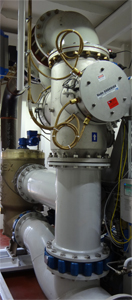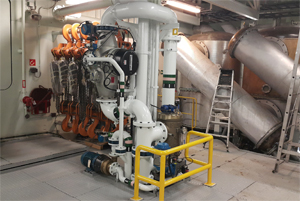Four companies are appealing the U.S. Coast Guard’s rejection of the testing methods they used to seek approval for ultraviolet ballast water management systems.
The methods were rejected in December because the Coast Guard said the test protocol did not meet agency regulations. The four companies that received the Coast Guard letter are Alfa Laval Tumba AB of Sweden, DESMI Ocean Guard A/S of Norway, Hyde Marine Inc. of Pennsylvania, and Trojan Marinex of Canada, according to Lisa Novak, spokeswoman for Coast Guard headquarters. All four companies are appealing the decision, she said.
The International Maritime Organization (IMO) and the Coast Guard, in conjunction with the U.S. Environmental Protection Agency, have been working for several years on rules to prevent the introduction of invasive water-borne organisms and pathogens into aquatic environments through ballast water discharge.
The Coast Guard’s final rule on ballast water discharge was published in 2012. An alternative management system (AMS) was added to the final rule to allow vessels that installed ballast water management systems (BWMS) before the IMO regulations came into force to operate in U.S. waters, according to Rear Adm. Paul Thomas, Coast Guard assistant commandant for prevention policy. As of Dec. 2 of last year, the Coast Guard had accepted more than 50 alternative management systems, Thomas wrote as part of series of blogs published on the Coast Guard Maritime Commons website. However, the AMS is only good for five years after the vessel is required to meet the regulations for BWMS. Ballast water treatment companies must still have their specific systems type-approved by the Coast Guard.
The dispute between the Coast Guard and the four companies centers around the method used to test for pathogens and the standard for viability of the organisms. The Coast Guard requires BWMS to be tested based on the ability to kill certain organisms, referred to as a live/dead standard. The IMO accepts a test that determines whether the organisms are viable/nonviable.
“The Coast Guard is really isolated in this,” said Rasmus Folso, chief executive of DESMI Ocean Guard. “Everyone else accepts this test method that the Coast Guard has now rejected.”
Folso said DESMI has been working with the Coast Guard on type approval of its system for more than two years. “It was our impression that we were making good progress and we were moving toward acceptance. That is why we were quite surprised with the rejection we received,” he said. DESMI has 30 models of its treatment systems accepted as an AMS.
Other manufacturers of ballast water systems also are frustrated by the Coast Guard rejections. The industry has created a website, Ballast Water & MPN (www.mpnballastwaterfacts.com), to make its case.
“Without notice or comment they rejected the UV protocol,” said Chris Todd, sales director for Hyde Marine. “Not based on science, but because they are not even allowed to consider the UV testing process. Frankly speaking, this letter could have been written three years ago.”
 |
|
Hyde's HG1000-ATB model at work aboard an articulated tug-barge. Hyde is one of four companies in disagreement with the U.S. Coast Guard over the testing methods used to approve systems. |
|
Courtesy Hyde Marine |
The four companies that received rejection letters maintain the method they use to test the viability of organisms, called the most probable number (MPN), meets Coast Guard standards and renders the organisms inert.
“We verified that the MPN is equally protective as the vital stain method,” said Mark Kustermans, marketing manager for Trojan Marinex. “It renders them harmless. If they can’t reproduce, they no longer become an invasive species.”
The vital stain method uses two fluorescent stains to evaluate organisms in ballast water. The industry claims that the vital stain method is not definitive or reliable.
“The MPN method is a well-established, sound scientific measurement that has been utilized for decades to demonstrate effective organism neutralization,” according to the industry website.
By rejecting the MPN method, the industry maintains that UV treatment systems will have difficulty getting Coast Guard approval. “The preliminary decision essentially prohibits the practical and efficient use of UV light-based systems for vessels that de-ballast in U.S. waters, and has the potential to impose widespread detrimental effects on the global shipping industry,” according to Ballast Water & MPN.
The Coast Guard does not consider the rejection of the MPN method as a bar to UV treatment systems. “If these same four systems are tested at a Coast Guard-approved independent laboratory and are found to meet the type-approval requirements, they will be approved,” said Novak. “The Coast Guard is aware of other UV BWMS which are undergoing evaluation using the prescribed tests.”
Thomas wrote in his blog that part of the problem involves confusion over the terms “living” and “viable.” The ballast water discharge standard in the IMO Ballast Water Management Convention is based on viable organisms. IMO guidelines specify that “viable” is defined as living. “Therefore, the U.S. interpretation of these guidelines has always been that ‘nonviable’ means dead,” Thomas wrote.
Another problem is the difficulty of determining whether organisms found in ballast water can reproduce after treatment. In addition, it may not be possible to culture all of the organisms found in ballast water in a laboratory because some cannot be induced to reproduce, Thomas wrote.
“Finally, it is not clear that organisms rendered nonviable will remain so over time. It has been shown that some organisms have repair mechanisms that can undo damage caused by ultraviolet radiation and thus restore the ability to reproduce,” he wrote.
The situation is further complicated by the fact that the IMO ballast water management rules are not yet in place. The IMO requires 35 percent of global tonnage to adopt the BWM Convention in order for it to be in force. As of mid-January, 47 countries had ratified the rules, but their combined tonnage is, at most, 34.56 percent of global tonnage, according to an IMO news release. The United States is not part of this convention.

